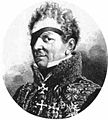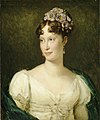Wilhelm Albrecht of Montenuovo

Prince Wilhelm Albrecht von Montenuovo (born August 8, 1821 in Parma , † April 6, 1895 in Vienna ) was an Austrian officer, most recently a general of the cavalry from the Montenuovo family .
Life
origin

He came from the morganatic marriage of Count Adam Albert Count von Neipperg (1775-1829) with Archduchess Marie-Louise of Austria (1791-1847), widow of Napoléon Bonaparte , and received the title of Count Montenuovo (Neuberg).
In February 1838 he joined the imperial army and became a lieutenant in the 5th Jäger Battalion. In 1839 he served as a first lieutenant in the Chevauxlegers Regiment No. 5 and in 1843 came as a major to the Dragoon Regiment No. 6. Count Montenuovo was then assigned to the Quartermaster General . In 1847 he was promoted to Lieutenant Colonel in Infantry Regiment No. 49 and in 1848 Cuirassier Regiment No. 4 to Colonel .
Campaign in Italy 1848
In April 1848 he hurried via Tyrol to the headquarters of Field Marshal Radetzky in Verona to take part in the war that had broken out against Savoy-Piedmont . Count Montenuovo took part in the capture of Pontebba (April 23), the battle near Pastrengo (April 29) and the battle of Santa Lucia (May 6). He then took part in the storming of the enemy positions at Curtatone (May 29), the Battle of Goito (May 30), the capture of Vicenza (June 19), the battle near Sommacampagna (July 23), fought in the battle of Custozza (July 25th) and Volta (July 25th and 27th). During the pursuit of the enemy over Cremona, subordinated to the division of Major General Franz von und zu Liechtenstein , he forced Fort Brescello , which belongs to the Duchy of Modena , to surrender on August 5th .
War against the Hungarian uprising
After taking Vienna by Prince Windisch-Graetz , he moved to the Danube army and took over on 15 November 1848, the command of the Chevauxlegers Regiment. 7. As a cavalry colonel his troops faced Trnava (December 16), fought against Raab (26 December 1848) near Windschacht and Schemnitz (January 21 and 22, 1849). His service in the Battle of Kápolna on February 27th earned him the Knight's Cross of the Leopold Order . He was then given command of a cavalry brigade with which he enlightened for the army of Prince Windisch-Grätz. Before Maklár he inhibited the Hungarians from winning and then forced them to retreat, on which he could secure the already lost guns of the Deym Brigade. On April 2nd and 5th he distinguished himself at Hort and before Hatvan and the following day at the battle of Isaszeg . His cavalry fought in all battles on the Rakosfeld and stood out in particular on April 26th in the battles of Puszta Hárkály and in the Ácser wood .

In the further course of the war he fought as regimental and brigade leader in the battles at Ács and Komorn , on August 9 at Vinga and on August 10 at Dreispitz (on August 10). Count Montenuovo was promoted to major general and was awarded the Military Cross of Merit. On August 24, 1849, he took over parts of the insurgent army from the Russians at Gyula as part of the arms extension of Világos and escorted them to Arad . For his armed act in the First Battle of Komorn he was awarded the Knight's Cross of the Maria Theresa Order by decision of March 26, 1850 and in September 1854 he was promoted to Lieutenant Field Marshal .
Campaign in 1859 and commanding general
In the campaign in Italy in 1859 during the Sardinian War , he temporarily commanded four brigades (on the Adda Line), then he participated as a divisional officer in the summer campaign in Lombardy. On June 4th he fought in the Battle of Magenta , on June 15th in the Battle of Castenedolo and finally on June 24th in the Battle of Solferino . For his performance in this campaign he was awarded the Order of the Iron Crown, 2nd class.
On his return from Italy his division was assigned to the II Corps in Vienna . On December 29, 1860, he was appointed a privy councilor, succeeding Prince Friedrich Liechtenstein as the commanding general in Transylvania . In November 1866 he took over the same position in Crown Land Bohemia. By imperial decree of July 20, 1864, Count Montenuovo was raised to the hereditary prince status, since 1858 he was also the owner of the 5th Hussar Regiment. In 1867 he was promoted to general of the cavalry and retired in 1878.
family
At the age of 31, he married the 23-year-old Juliana Johanna Marie Stephanie, born Countess Batthyány -Strattmann (* June 10, 1827, † November 19, 1871) in Vienna on May 18, 1850 . She was the lady of the star cross and palace of the Empress of Austria and died at the age of 44. Her parents were János Baptist Batthyány-Strattmann (Count Batthyány-Strattmann) (1784-1865) and Marie Esterházy de Galántha (Countess Esterházy de Galántha) (1791-1830). Through his wife Juliana Countess Batthyány-Strattmann came u. a. Margarethen am Moos Castle also became the property of the Montenuovo family. There were three children from this marriage: a son and two daughters:
- Albertine (born June 30, 1853; † 1895 Chroberz Castle (Poland)) married Count Zygmunt Wielopolski (1833–1902) twenty years her senior in Schwaigern , Württemberg in 1873
- Alfred von Montenuovo (born September 16, 1854 in Vienna; † September 6, 1927, ibid), later the 2nd Prince of Montenuovo and heir to Margarethen Castle on Moos
- Marie (born September 10, 1859 in Vienna † March 2, 1911 ibid) married Count Anton Apponyi de Nagyappony on May 23, 1878 (born December 29, 1852 in Vienna; † February 4, 1920 in Bad Ischl)
Father Adam Albert Graf Neipperg (1775–1829)
Mother Marie-Louise of Austria (1791–1847)
older sister Albertine-Marie von Montenuevo (1817–1847)
Schwaigern Castle Ancestral seat of the Counts Neipperg
literature
- Jaromir Hirtenfeld : The Military Maria Theresa Order and its members , Vienna 1857, pp. 1672–1676
- Constantin von Wurzbach : Montenuovo, Wilhelm Albrecht Prince of . In: Biographisches Lexikon des Kaiserthums Oesterreich . 19th part. Imperial and Royal Court and State Printing Office, Vienna 1868, pp. 50–54 ( digitized version ).
- Meyers Großes Konversations-Lexikon , Sixth Edition, 1904–1911
- Peter Broucek : Montenuovo, Wilhelm Albrecht Prince of. In: Austrian Biographical Lexicon 1815–1950 (ÖBL). Volume 6, Verlag der Österreichischen Akademie der Wissenschaften, Vienna 1975, ISBN 3-7001-0128-7 , p. 361 f. (Direct links on p. 361 , p. 362 ).
Web links
- Family tree of the Batthyány-Strattmann family
- Margarethen am Moos Castle, formerly the family seat
- Former Palais of Wilhelm Albrecht von Montenuovo, Vienna, Strauchgasse from 1851
Individual evidence
- ↑ according to son's obituary on April 6, 1895
| personal data | |
|---|---|
| SURNAME | Montenuovo, Wilhelm Albrecht von |
| ALTERNATIVE NAMES | Montenuovo, Wilhelm Albrecht Fürst von (full name) |
| BRIEF DESCRIPTION | Austrian general |
| DATE OF BIRTH | August 8, 1821 |
| PLACE OF BIRTH | Parma |
| DATE OF DEATH | April 6, 1895 |
| Place of death | Vienna |






